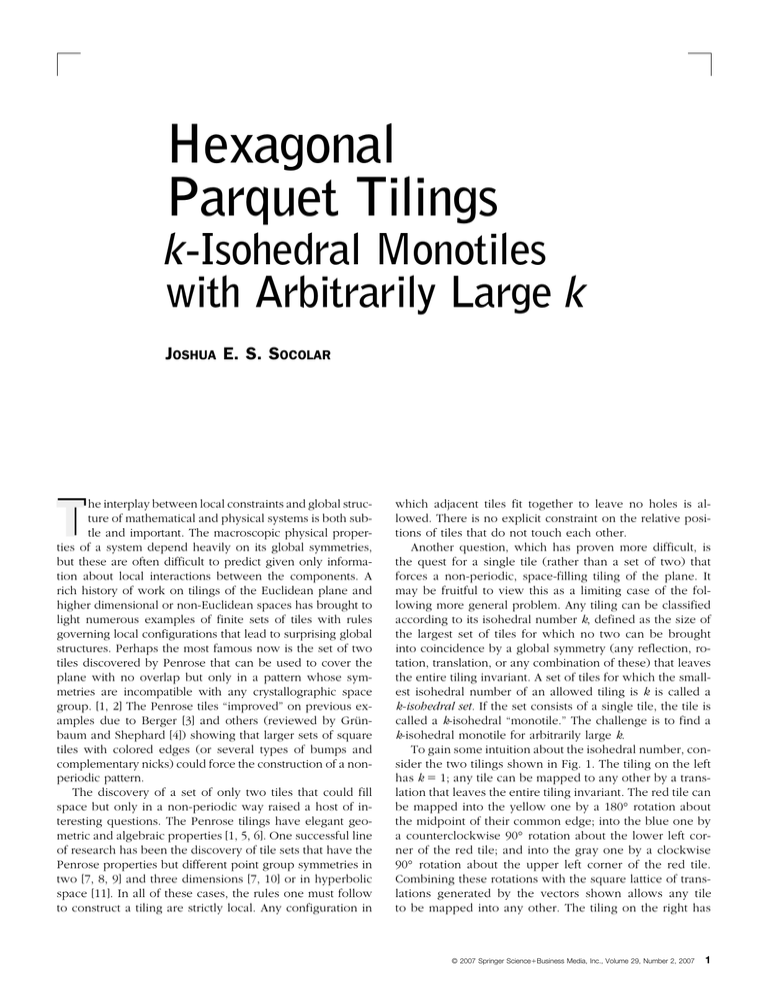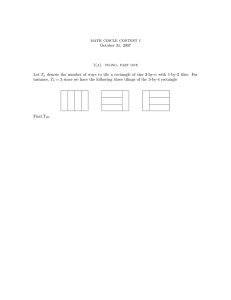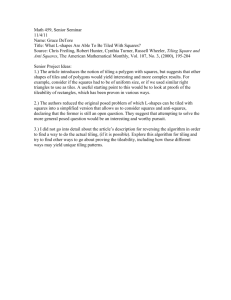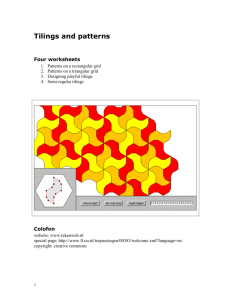T Hexagonal Parquet Tilings k-Isohedral Monotiles
advertisement

Hexagonal Parquet Tilings k-Isohedral Monotiles with Arbitrarily Large k JOSHUA E. S. SOCOLAR T he interplay between local constraints and global structure of mathematical and physical systems is both subtle and important. The macroscopic physical properties of a system depend heavily on its global symmetries, but these are often difficult to predict given only information about local interactions between the components. A rich history of work on tilings of the Euclidean plane and higher dimensional or non-Euclidean spaces has brought to light numerous examples of finite sets of tiles with rules governing local configurations that lead to surprising global structures. Perhaps the most famous now is the set of two tiles discovered by Penrose that can be used to cover the plane with no overlap but only in a pattern whose symmetries are incompatible with any crystallographic space group. [1, 2] The Penrose tiles “improved” on previous examples due to Berger [3] and others (reviewed by Grünbaum and Shephard [4]) showing that larger sets of square tiles with colored edges (or several types of bumps and complementary nicks) could force the construction of a nonperiodic pattern. The discovery of a set of only two tiles that could fill space but only in a non-periodic way raised a host of interesting questions. The Penrose tilings have elegant geometric and algebraic properties [1, 5, 6]. One successful line of research has been the discovery of tile sets that have the Penrose properties but different point group symmetries in two [7, 8, 9] and three dimensions [7, 10] or in hyperbolic space [11]. In all of these cases, the rules one must follow to construct a tiling are strictly local. Any configuration in which adjacent tiles fit together to leave no holes is allowed. There is no explicit constraint on the relative positions of tiles that do not touch each other. Another question, which has proven more difficult, is the quest for a single tile (rather than a set of two) that forces a non-periodic, space-filling tiling of the plane. It may be fruitful to view this as a limiting case of the following more general problem. Any tiling can be classified according to its isohedral number k, defined as the size of the largest set of tiles for which no two can be brought into coincidence by a global symmetry (any reflection, rotation, translation, or any combination of these) that leaves the entire tiling invariant. A set of tiles for which the smallest isohedral number of an allowed tiling is k is called a k-isohedral set. If the set consists of a single tile, the tile is called a k-isohedral “monotile.” The challenge is to find a k-isohedral monotile for arbitrarily large k. To gain some intuition about the isohedral number, consider the two tilings shown in Fig. 1. The tiling on the left has k 1; any tile can be mapped to any other by a translation that leaves the entire tiling invariant. The red tile can be mapped into the yellow one by a 180° rotation about the midpoint of their common edge; into the blue one by a counterclockwise 90° rotation about the lower left corner of the red tile; and into the gray one by a clockwise 90° rotation about the upper left corner of the red tile. Combining these rotations with the square lattice of translations generated by the vectors shown allows any tile to be mapped into any other. The tiling on the right has © 2007 Springer ScienceBusiness Media, Inc., Volume 29, Number 2, 2007 1 Figure 1. A 1-isohedral tilings and a 2-isohedral tiling. AUTHOR k 2. It has the same symmetries as the one on the left, but there is no symmetry that maps the green tile into the orange one; there are two “inequivalent types” of tiles in this tiling. The answer to this question “Is there a k-isohedral monotile?” for arbitrarily large k depends crucially on how the question is posed. As we will see below, there are many subtly different versions of this and similar questions, and versions that may at first glance appear equivalent turn out not to be. Forcing nontrivial global structure of a certain precisely defined type can be accomplished in a variety of ways depending on what types of local matching rules are deemed permissible. We will assume that the rules are applicable only to tiles that share (some portion of ) an edge. But shall we require that the monotile be completely defined by its shape alone? Or shall we allow coloring of the edges and specification of which colors are allowed to coincide? Shall we insist that the monotile be a simply connected shape? Shall we insist that the tiling cover the entire plane, or just that it have the highest possible density? Recent exhaustive searches of polyomino monotiles consisting of square, triangular, or hexagonal units have produced k-isohedral examples with k as large as 10 (so far!) [12], but there appears to be no systematic way construct such examples analytically. In these examples, the matching rules are enforced by shape alone and the entire space must be covered. Below we present several variations of a class of monotiles and matching rules that can force tilings with arbitrarily large k. The tilings formed all have the basic structure of the hexagonal parquet shown in Fig. 2. Each rhombus in the figure is composed of L 5 monotiles. Generalization to arbitrarily large L is clearly possible. (Exercise: Find the isohedral number of the hexagonal parquet in terms of L. Answer below.) JOSHUA SOCOLAR received his PhD in Physics from the University of Pennsylvania in 1987, with a thesis on quasilattices and quasicrystals. He has been on the faculty at Duke since 1992, where he is attached both to the Center for Nonlinear and Complex Systems and to the Center for Systems Biology. His hobbies include music and (his son’s influence) bird-watching. Physics Department and Center for Nonlinear and Complex Systems Duke University Durham, NC 27708 USA e-mail: socolar@phy.duke.edu 2 In each of the following four sections, we present a monotile and matching rule that forces a tiling with the symmetry of the hexagonal parquet. The difference between the tilings lies in the way in which the rule is expressed. Defining a tile to be the closed set of points bounded by the tile edges (and faces in higher dimensions), we have the following four cases. In all cases, we allow tiles to overlap only along edges. 1. The edges of the monotile are colored, there are rules constraining which colors can coincide, and the tiles cover the entire space. 2. The edges are not colored. The rule is that the tiles must cover the entire space, but the tile is not a simply connected shape. 3. The monotile is simply connected and the rule is that the tiling must maximize the density of tiles without necessarily covering the entire space. 4. The (3D) monotile is a simply connected shape and the only rule is that the tiles must fill the space (or just an infinite slab thick enough to accommodate the height of one tile). In this work we allow only rotations and translations of the monotile, not reflections. All of the results can be easily extended to the case where reflections are allowed by replacing the disks, bumps, and nicks with chiral shapes. Perhaps just as important as the discovery of monotiles that force any desired isohedral number, these examples show that subtle differences in the rules of the game may generate dramatically different results. Note that we have not exhibited a simply connected, uncolored, twodimensional monotile that forces the hexagonal parquet structure. In fact, we show below that this is impossible. If you want to restrict the problem to these terms, the record in two dimensions is still Myers’ polyomino consisting of a simply connected cluster of 16 hexagons. [12] THE MATHEMATICAL INTELLIGENCER The tile shown in Fig 3a is endowed with a matching rule requiring that no two red edges may touch. As the aspect ratio of the tile is increased in integer steps, the minimal isohedral number of a space-filling tiling formed with this tile increases without bound. T HEOREM 1 Let T be a parallelogram tile with angles of 60° and 120° and side lengths 1 and L 1, where L is an integer. (See Fig. 3a.) Color the short edges of T red (not including the vertices) and the long edges (and vertices) black. The minimal isohedral number of a tiling in which no points are covered twice with red is (L 1)/2 . A B Proof. Consider the tile T1 shown in Fig. 3b. The matching rule and requirement of space filling immediately imply that T2 must be present. The only way to continue the tiling is then to place T3 and T4 as shown with dashed outlines. The process of adding forced tiles stops only when the ends of T2 are reached through further additions of tiles along its bottom edge. At this point, T5 in Fig. 3c is forced and the process repeats until the hexagon of Fig. 3c is formed. The existence of this hexagon in the tiling ensures that the isohedral number of the tiling is at least (L 1)/2 . Each tile can be characterized by the distance of its center from the center of the rhombus containing it, with tiles on opposite sides of the center possibly related by rotation of 180° about the center. By inspection it is clear that the hexagons can tile the plane while respecting the matching rules, forming a stan- dard honeycomb lattice in which the isohedral number is exactly (L 1)/2 . B A 2D Monotile with Color Matching Rules Figure 3. The L 5 hexagonal parquet monotile: (a) the tile; (b) forced tiles; (c) the forced hexagon. A Figure 2. The L 5 hexagonal parquet tiling of the plane. Each “board” is a copy of the same tile. T HEOREM 2 For L 2, the color matching rule for the monotile T cannot be enforced by alterations of the tile shape alone; i.e., by placing bumps and nicks on the tile edges. Proof. Let the shape of one red edge be designated R 1 and the shape of the other red edge be R 2. Further, let R 1 and R 2 be the complementary shapes that fit onto R 1 and R 2, respectively. The color matching rule implies that neither R1 nor R2 is congruent to R 1 or R 2. We will now show that the number of instances of Rx on the tile must be greater than the number of instances of R x , which immediately implies that T cannot tile the plane. Consider any tile in the interior of a rhombus, which has both black edges matching black edges of its neighbors. Let the shapes of the two black edges be B1 and B 2. There are two possibilities: (1) B1 B2, which implies B 2 B1; or (2) rB 1 B 1 and rB 2 B2, where rX indicates rotation of X by . In either case, any instance of Rx found on B1 must be matched by an instance of Rx either on B 2 or on rB1. Thus the number of instances of Rx on black edges cannot exceed the number of instances of Rx. This means that the single Rx on the red edge makes the number of Rx’s larger. The conclusion is that in order to tile the plane, the red edge matching rule has to be relaxed, but this in turn permits simple periodic tilings with isohedral numbers or one or two. A B Figure 4. An L 5 multiple connected monotile (gray) that forces the hexagonal parquet tiling. Colors are guides to the eye to help identify individual tiles. © 2007 Springer ScienceBusiness Media, Inc., Volume 29, Number 2, 2007 3 Figure 5. A simply connected monotile that forces hexagonal parquet layers that can be stacked to fill space. Top, bottom, and tiling views. Figure 6. A monotile that forces a double-layered hexagonal parquet and a unit cell of space-filling tiling. Top and bottom views. Forcing the Hexagonal Parquet with a Multiply Connected Monotile The color matching rule for the hexagonal parquet monotile can be enforced by shape alone if one does not insist on T being simply connected. The proof is by construction, as displayed in Fig. 4. The seven black regions at the left of the figure form the monotile. By inspection, it is clear that there is no way to have two short edges of the basic parallelogram coincide. (The nearby disks or protruding rods get in the way.) Thus the rules for how the parallelograms can be placed are at least as restrictive as the color matching rules discussed above. The figure clearly shows, however, that the hexagonal parquet tiling can still be formed. Forcing the Hexagonal Parquet with a Simply Connected 3D Monotile The color matching rule required for the hexagonal parquet tile can also be implemented with a simply connected monotile in three dimensions. The simplest way to do it is to promote the multiply connected 2D monotile on the right in Fig. 4 to a 3D parallelepiped with shallow protruding rods and grooves as shown in Fig. 5. The complete tiling is a stacking of identical hexagonal parquet layers. The lowest permitted isohedral number for the space-filling 3D tiling is the one in which the layers are in perfect registry. This can be forced, if desired, by placing bumps on the rods at the positions corresponding to the disk centers in the monotile of the left panel of Fig. 4 and corresponding dents in the bottom of the parallelepiped. Note that the pattern of disks in Fig. 4 is not a triangular lattice, so the registry is indeed forced. The multiply connected tiling on the left in Fig. 4 suggests a different strategy for constructing a 3D monotile. The tiling now consists of stacks of double layers, each double layer being a hexagonal parquet with flat top and bottom surfaces. The enforcement of the matching rule for the top of the double layer is provided by the pieces of tile on the bottom of the double layer. The protrusions and Figure 7. A simply connected monotile that forces a double-layered hexagonal parquet. 4 THE MATHEMATICAL INTELLIGENCER Figure 8. An L 5 monotile (top) for which the hexagonal parquet is the maximum density tiling. indentations on the top surface of the bottom-layer pieces do not fit properly into those in the top-layer piece when one attempts to match the top pieces end to end. Thus one is forced to form a hexagonal parquet in a manner quite similar to the multiply connected 2D tiling above, with the bottom-layer pieces playing exactly the same role as the isolated disks in the 2D monotile. One realization of this 3D monotile and one unit cell of the double layer are shown in Fig. 6, each being shown from viewpoints above and below the plane of the double layer. The monotile of Fig. 6 would not be simply connected if we took the tile to be the open set not containing edges. The construction can be modified, however, so as to make even this open set simply connected. The L 4 version of the modified tile is shown in Fig. 7. The protruding “legs” from the top-layer piece will fit into the grooves in the bottom-layer piece, with two legs (one from each of two neighboring tiles) filling each hole formed by neighboring tiles on the bottom layer. The legs protruding from the end of the top-layer piece and fitting into half of the groove on the end of each bottom-layer piece form a connection that makes the whole tile simply connected. Forcing the Hexagonal Parquet with a Maximum Density Rule The hexagonal parquet can be enforced by a simply connected shape in 2D if one replaces the space-filling constraint with the demand that the tiling have the maximum possible tile density. The shape in Fig. 8 can form a hexagonal parquet tiling as shown. The color matching rule is enforced by the bumps on the ends of the tile. The parquet tiling is then the maximum density tiling that can be achieved with this tile. Because the smallest excluded area around a tile occurs when its ends are fitted into notches, every tile in the parquet tiling excludes the smallest area possible. Conclusions We have exhibited several types of monotiles with matching rules that force the construction of a hexagonal parquet. The isohedral number of the resulting tiling can be made as large as desired by increasing the aspect ratio of the monotile. Aside from illustrating some elegant peculiarities of the hexagonal parquet tiling, the constructions demonstrate three points: 1. Monotiles with arbitrarily large isohedral number do exist; 2. The additional topological possibilities afforded in 3D allow construction of a simply connected monotile with a rule enforced by shape only, which is impossible for the hexagonal parquet in 2D; 3. The precise statement of the tiling problem matters— whether color matching rules are allowed; whether multiply connected shapes are allowed; whether spacefilling is required as opposed to just maximum density. So what about the quest for the k monotile? Schmitt, Danzer and Conway have exhibited a 3D monotile that forces a non-periodic tiling. [13, 14, 15] The tiling is a stacking of identical layers and each layer is a periodic packing of the monotile. The nonperiodicity arises because the planar lattice directions in successive layers are rotated by an angle incommensurate with 2. This tiling has an unusual feature: the number of local configurations around a monotile is infinite. That is, no two tiles in a given layer are covered in exactly the same way by the tiles in the layers above and below it. In fact, the layers can slide over each other to form an infinite number of tilings that are not related by any global symmetry. For rotation angles with a rational tangent, bumps and nicks can be placed on the tiles such that the number of nearest neighbor environments is finite, but the isohedral number of the full 3D tiling is still infinite due to the different sequences of local environments intersected by different lines normal to the layers. Another example of a k monotile is the decagonal tile together with matching rules allowing certain types of overlap first presented by Gummelt. [16] Jeong and Steinhardt proved that the overlap rules and the requirement that the tile density be maximized force a structure with the same symmetries as the Penrose tiling. [17] At present there is no general theory distinguishing patterns that can be enforced by color matching rules from those that can be enforced by shape alone or by maximum density constraints. The maximum density criterion is of particular interest in physics—and is particularly vexing because of the difficulty of linking this global criterion to local constraints that can be exhaustively checked. In some cases, such as the hexagonal parquet case above, it can be proven that satisfying certain local constraints will guarantee maximum density. The recent proof that the FCC packing of spheres in three dimensions has maximum density is another example. [18] On the other hand, there is some evidence that the maximum density sphere packing in many dimensions is actually a random packing [19], which would have an infinite isohedral number and an infinite number of local configurations around a single sphere (monotile). As the examples described above suggest, there may be surprisingly simple links between local rules and global structure, and the collection of interesting specimens has yet to be placed within a well-defined theoretical framework. Tiling enthusiasts around the world are looking for new ideas and examples that will lead to deeper understanding, enjoying the recreational nature of the puzzles that crop up, and appreciating the visual and logical structures that emerge along the way. © 2007 Springer ScienceBusiness Media, Inc., Volume 29, Number 2, 2007 5 ACKNOWLEDGMENTS I thank C. Goodman-Strauss and M. Senechal for their generous mathemathical and editorial advice. REFERENCES [1] R. Penrose, “Pentaplexity,” Math. Intelligencer, 2, 32 (1979). [2] M. Gardner, “Extraordinary nonperiodic tiling that enriches the theory of tiles,” Sci. Am., 236, 110 (1977). [3] R. Berger, “The undecidability of the Domino problem,” Mem. Amer. Math. Soc. 66 (1966). [4] B. Grünbaum and G. C. Shephard, Tilings and Patterns, (Freeman, New York, 1987). [5] N. G. de Bruijn, “Algebraic theory of Penrose’s non-periodic tilings of the plane,” Kon. Nederl. Akad. Wetensch. Proc. Ser. A, 43, 27 (1981); and 43, 39 (1981). [6] D. Levine and P. J. Steinhardt, “Quasicrystals: A New Class of Ordered Structures,” Phys. Rev. Lett. 53, 2477 (1984). [7] R. Ammann, unpublished. [8] J. E. S. Socolar, “Simple octagonal and dodecagonal quasicrystals,” Phys. Rev. B, 39, 10519 (1989). [9] J. E. S. Socolar, “Weak matching rules for quasicrystals,” Comm. Math. Phys. 129, 599 (1990). 6 THE MATHEMATICAL INTELLIGENCER [10] J. E. S. Socolar and P. J. Steinhardt, “Quasicrystals II: Unit cell structures,” Phys. Rev. B, 34, 617 (1986). [11] C. Goodman-Strauss, “A strongly aperiodic set of tiles in the hyperbolic plane,” Inventiones Mathematicae, 159, 119 (2005). [12] J. S. Myers, “Polyomino tiling,” http://www.srcf.ucam.org/jsm28/ tiling/ (2005). [13] L. Danzer, “A family of 3D-spacefillers not permitting any periodic or quasiperiodic tiling,” in Aperiodic ’94, edited by G. Chapius (World Scientific, Singapore, 1995). [14] M. Baake and D. Frettloh, “SCD patterns have singular diffraction,” J. Math. Phys. 46 033510 (2005). [15] C. Radin, “Aperiodic tilings in higher dimensions,” Proc. American Mathematical Soc., 123, 3543 (1995). [16] P. Gummelt, “Penrose tilings as coverings of congruent decagons,” Geometriae Dedicata, 62, 1 (1996). [17] P. J. Steinhardt and H.-C. Jeong, “A simpler approach to Penrose tiling with implications for quasicrystal formation,” Nature, 382, 431 (1996). [18] T. C. Hales, “A proof of the Kepler conjecture,” Ann. of Math. 162, 1065 (2005). [19] S. Torquato and F. H. Stillinger, “New conjectural lower bounds on the optimal density of sphere packings,” Experiment. Math., 15, 307–332 (2006).





